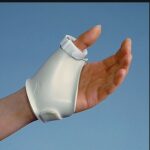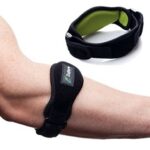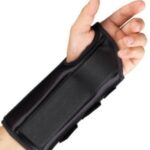
The Orthopedic Growing Pains of Parenting
Leave a CommentHave you ever paid attention to the amount of times you lift or handle your newborn child or toddler throughout the day? As a parent of two growing children under the age of two, I could not help but notice (and feel the effects of) the physical demands of my kids. The bulky-but-useful changing stations, running strollers, ergo-carriers, standing towers, and bassinets all require lifting and/or carrying the child while assisting them into some (not always desired but necessary) positions. You do what you must as parents, but how exactly are you getting the job done and at what orthopedic cost? Here is a list of some common overuse injuries as well as a few tips that may prevent them with just a few seconds of extra thought and planning!
Injury: De Quervain’s Tenosynovitis
De Quervain’s is a painful condition affecting the tendons on the thumb side of the wrist. Parents, especially mothers of young children, are often at risk due to the anatomy and positioning required for the typical lifting of a child from under the armpit region. Forceful, sustained thumb abduction (making an L with thumb and first finger) with ulnar wrist deviation (wrists positioned towards floor when lifting) may contribute to developing this condition.1
Prevention: Instead of lifting your child from under the armpit region, start by standing behind your child. Reach your hand around and across their chest while using the other hand to scoop their bottom half way between their knees and buttocks region in order to perform a scooping-cradling position. Size of the child and strength of parents will play a role in alternative lifting. Of note, wearing a hard, and static thumb splint can also assist with managing thumb/wrist pain.1
 Thumb splint Photo courtesy of PerformanceHealth.com |
Injury: Lateral Epicondylitis (Tennis Elbow)
Commonly known as Tennis Elbow, resisted extension of the wrists while gripping/lifting can place an increased load and force on the extensor tendons at the elbow. If you’re anything like me, I notice this when I am trying to throw open my large and heavy double stroller.
Prevention: Instead, try laying the stroller on the floor, and unfold it step by step. Once ready to bring it upright, use an underhand grip (palms facing the sky) or neutral grip (palms facing one another) to lift and pull. A wrist brace and elbow counter force brace can also help to manage pain associated with this injury.
 Elbow counter force brace Photo courtesy of Heavy.com |
 Wrist brace Photo courtesy of Walmart.com |
Injury: Shoulder Impingement Syndrome
This type of injury can easily occur when performing child care activities such as lifting a child, passing a child from one person to another, getting up from the floor, organizing your storage closet, looking for toys/pacifiers under the couch, or almost anything involving reaching with or without resistance. When the rotator cuff muscles rub onto the bony anatomy of the shoulder causing inflammation, it may narrow the already small space where these tendons live creating a lot of pain and/or weakness with reaching and lifting activities.
Prevention: Be sure to always hold children/objects close to your body’s center and not outside your base of support. To do this, pretend there is a small circle around yourself, and keep your child or lifted object within that circle to avoid mechanical stress on the rotator cuff.1
When Parenting Causes Pain
Parenting is such a challenging and rewarding experience. It is important that we first take care of ourselves, so that we can provide the best care possible for our children. Keeping in mind our body mechanics, positioning, and ways we handle our kids and their equipment, can all minimize the risk for any orthopedic-related pain and injury standing in the way of you and your child’s needs. If you’re experiencing pain or injury, reach out to your nearest Athletico for a Free Assessment. Free Assessments are available in-clinic and virtually through our Telehealth platform.
The Athletico blog is an educational resource written by Athletico employees. Athletico bloggers are licensed professionals who abide by the code of ethics outlined by their respective professional associations. The content published in blog posts represents the opinion of the individual author based on their expertise and experience. The content provided in this blog is for informational purposes only, does not constitute medical advice and should not be relied on for making personal health decisions.
Reference
1. Cooper, Cynthia, 2014. Fundamentals of Hand Therapy; Clinical Reasoning and Treatment Guidelines for Common Diagnoses of the Upper Extremity.
